-

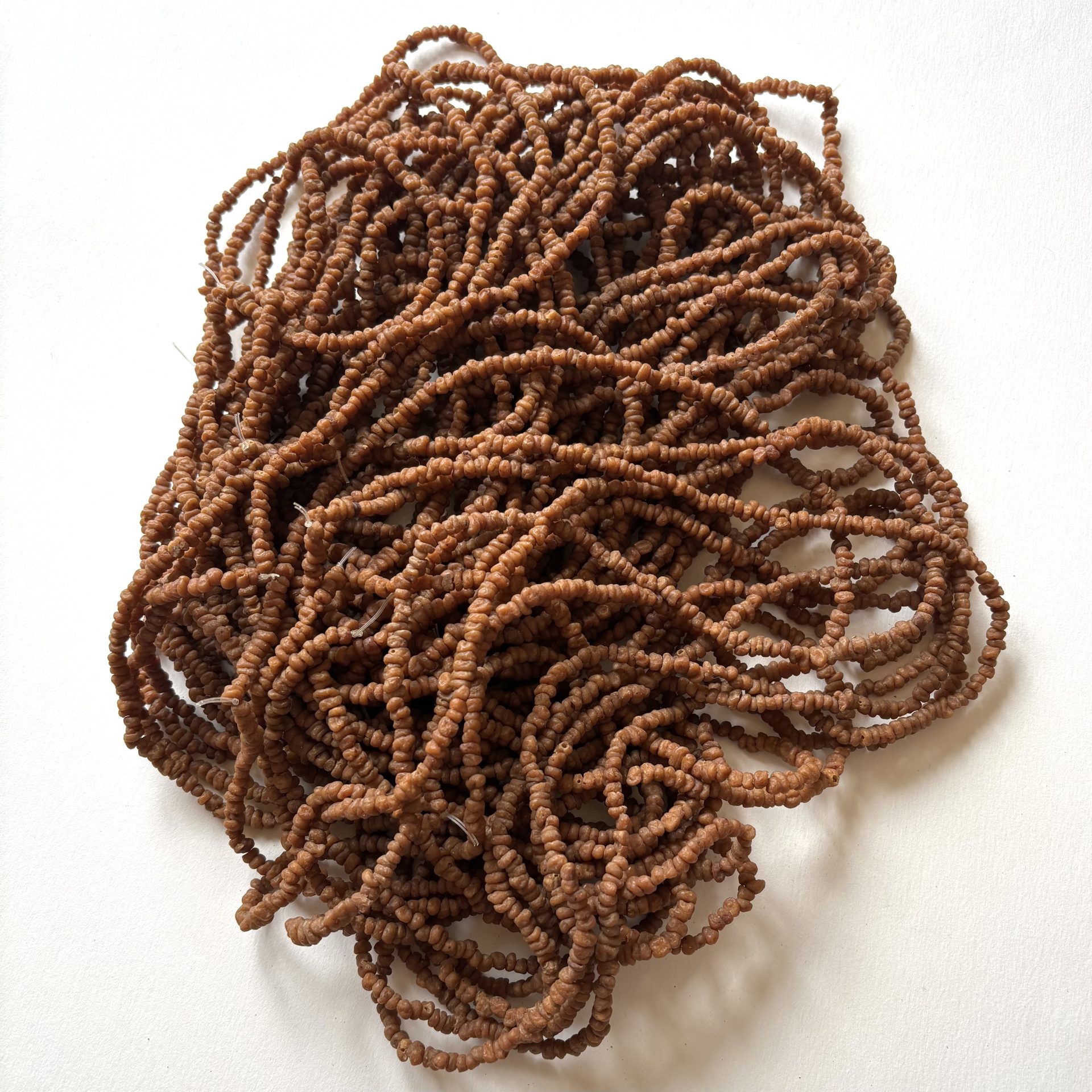 Yes. Myrrh. As in Frankinscense and Myrrh. 6 strands of Myrrh Beads 32" long found in the largest beads market in Western Africa, Koforidua Beads Market. The beads are made from the sap of the Commiphora tree. "Both frankincense and myrrh are resins – hardened sap from trees. In both cases, trees are slashed and allowed to “bleed.” The sap that comes from the trees hardens and forms beads or “tears.” While frankincense is used for incense and myrrh is mainly used in oral preparations, they both have many more uses. Myrrh was highly esteemed by the ancients; in the Middle East and Mediterranean regions, it was an ingredient of costly incenses, perfumes, and cosmetics and was used in medicines for local applications and in embalming."
Yes. Myrrh. As in Frankinscense and Myrrh. 6 strands of Myrrh Beads 32" long found in the largest beads market in Western Africa, Koforidua Beads Market. The beads are made from the sap of the Commiphora tree. "Both frankincense and myrrh are resins – hardened sap from trees. In both cases, trees are slashed and allowed to “bleed.” The sap that comes from the trees hardens and forms beads or “tears.” While frankincense is used for incense and myrrh is mainly used in oral preparations, they both have many more uses. Myrrh was highly esteemed by the ancients; in the Middle East and Mediterranean regions, it was an ingredient of costly incenses, perfumes, and cosmetics and was used in medicines for local applications and in embalming." -
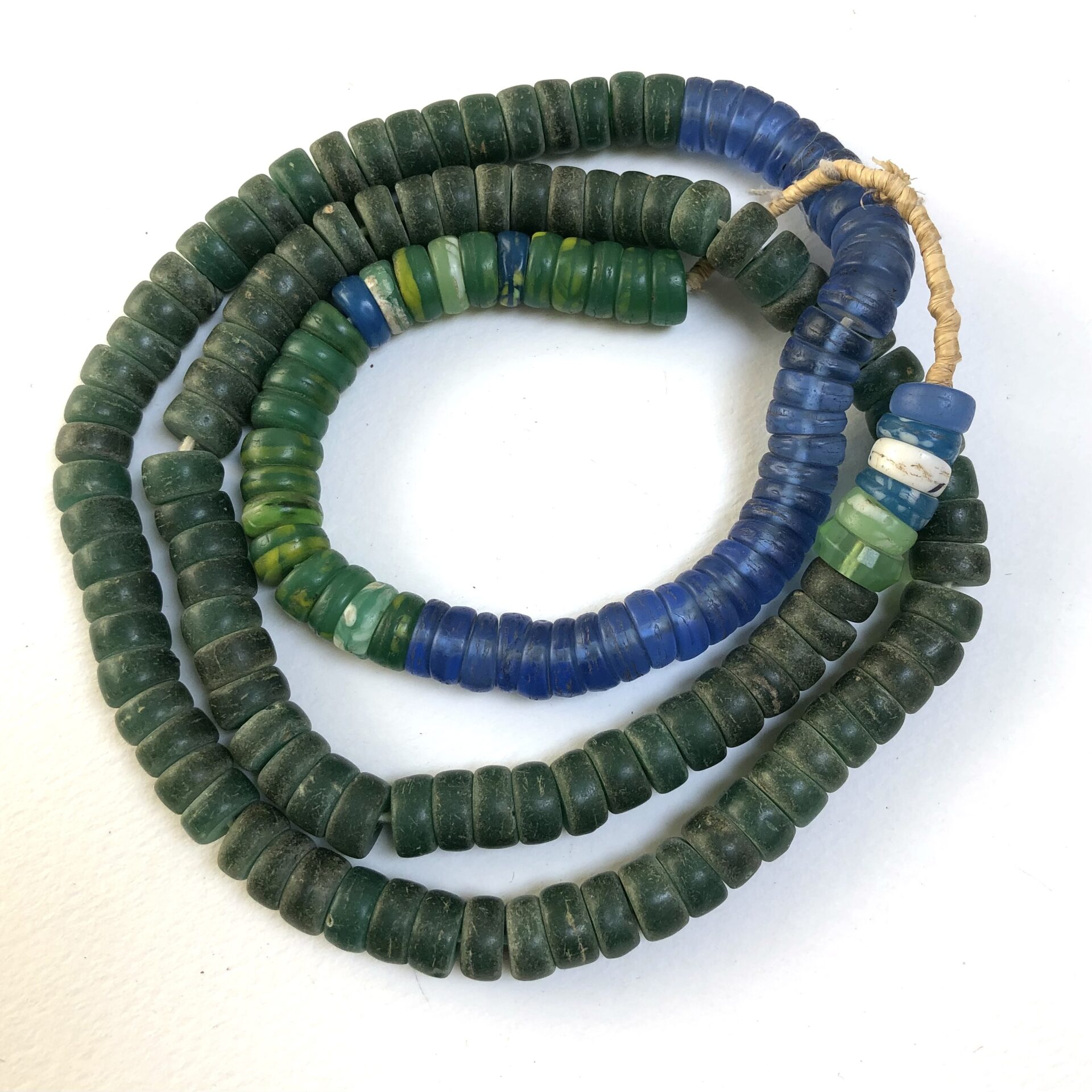
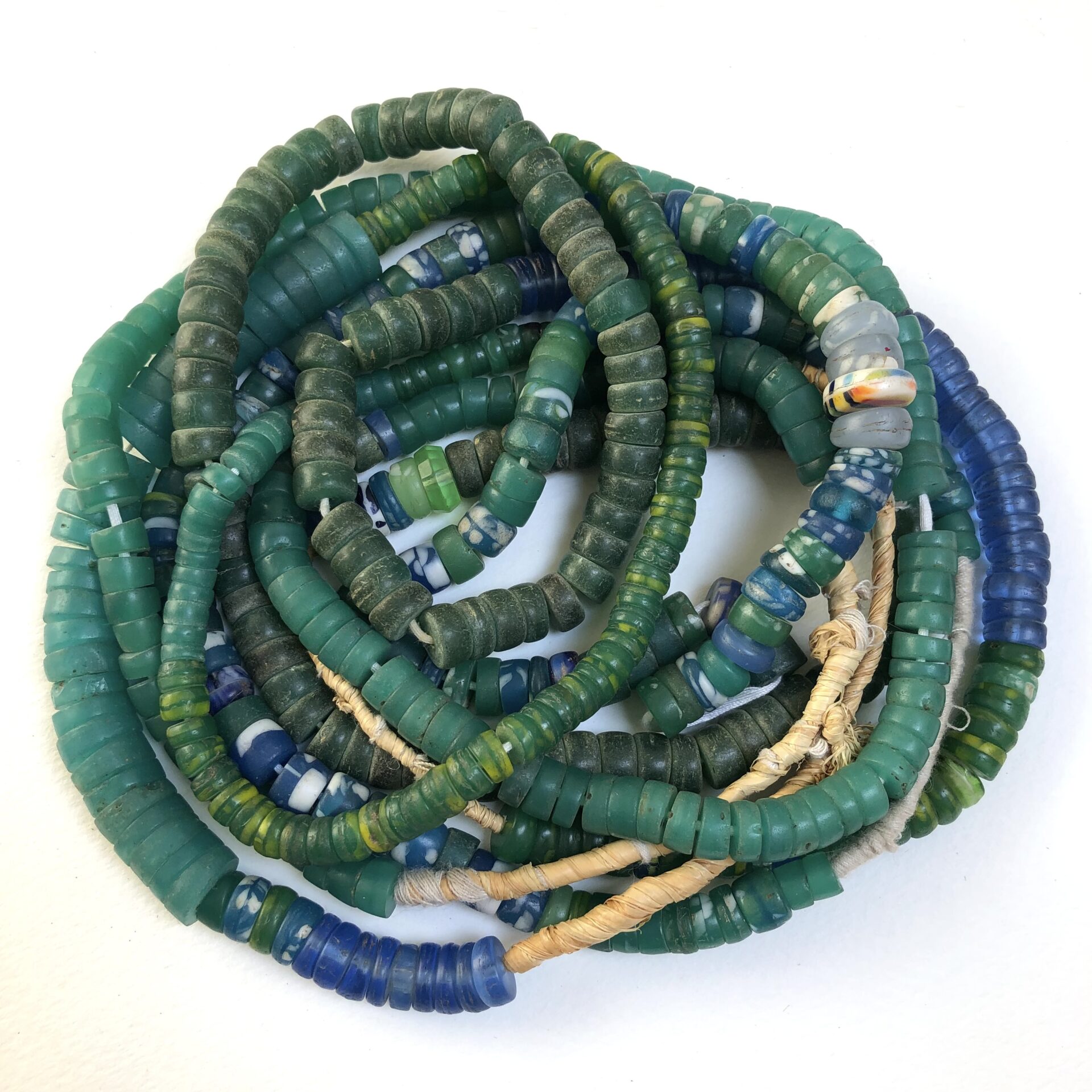 There are 4 strands of Kakamba Prosser for you to choose from. These are great spacer beads. Prosser beads are by extension any beads made by the 'Prosser' technique, invented by the Prosser brothers in 1840 in England for the purpose of making buttons. The process consists of molding a cold paste under great pressure and then firing it. Prosser Beads were distinct from other European trade beads in that they were produced in a great variety of colors, and were also translucent. They were received particularly well in the town of Kakamba in the Republic of the Congo – hence the name Kakamba Prosser Beads.
There are 4 strands of Kakamba Prosser for you to choose from. These are great spacer beads. Prosser beads are by extension any beads made by the 'Prosser' technique, invented by the Prosser brothers in 1840 in England for the purpose of making buttons. The process consists of molding a cold paste under great pressure and then firing it. Prosser Beads were distinct from other European trade beads in that they were produced in a great variety of colors, and were also translucent. They were received particularly well in the town of Kakamba in the Republic of the Congo – hence the name Kakamba Prosser Beads. -
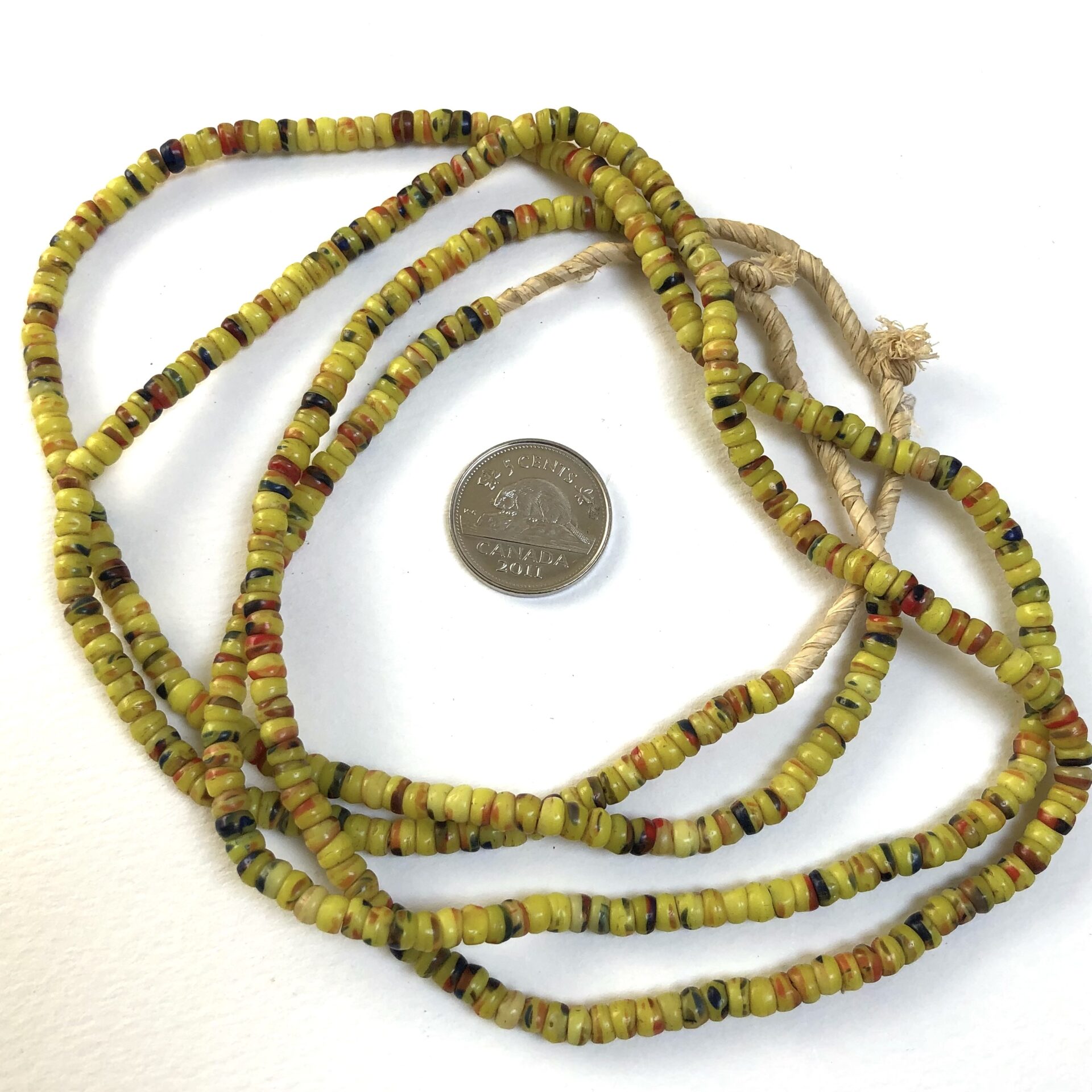
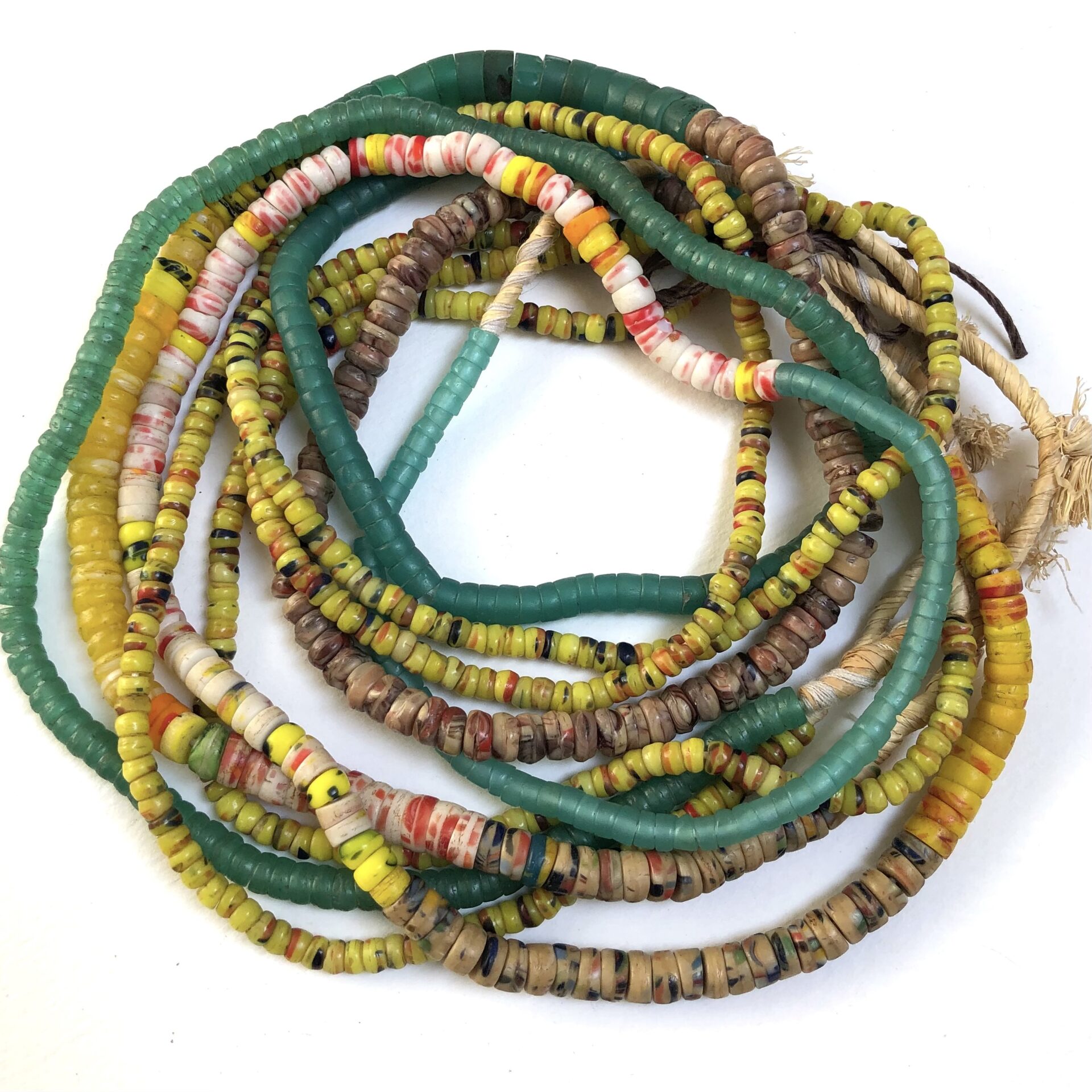 A strand of Kakamba Prosser Beads about 24" long. There are 4 strands for you to choose from. These are great spacer beads. Prosser beads are by extension any beads made by the 'Prosser' technique, invented by the Prosser brothers in 1840 in England for the purpose of making buttons. The process consists of molding a cold paste under great pressure and then firing it. Prosser Beads were distinct from other European trade beads in that they were produced in a great variety of colors, and were also translucent. They were received particularly well in the town of Kakamba in the Republic of the Congo – hence the name Kakamba Prosser Beads.
A strand of Kakamba Prosser Beads about 24" long. There are 4 strands for you to choose from. These are great spacer beads. Prosser beads are by extension any beads made by the 'Prosser' technique, invented by the Prosser brothers in 1840 in England for the purpose of making buttons. The process consists of molding a cold paste under great pressure and then firing it. Prosser Beads were distinct from other European trade beads in that they were produced in a great variety of colors, and were also translucent. They were received particularly well in the town of Kakamba in the Republic of the Congo – hence the name Kakamba Prosser Beads. -
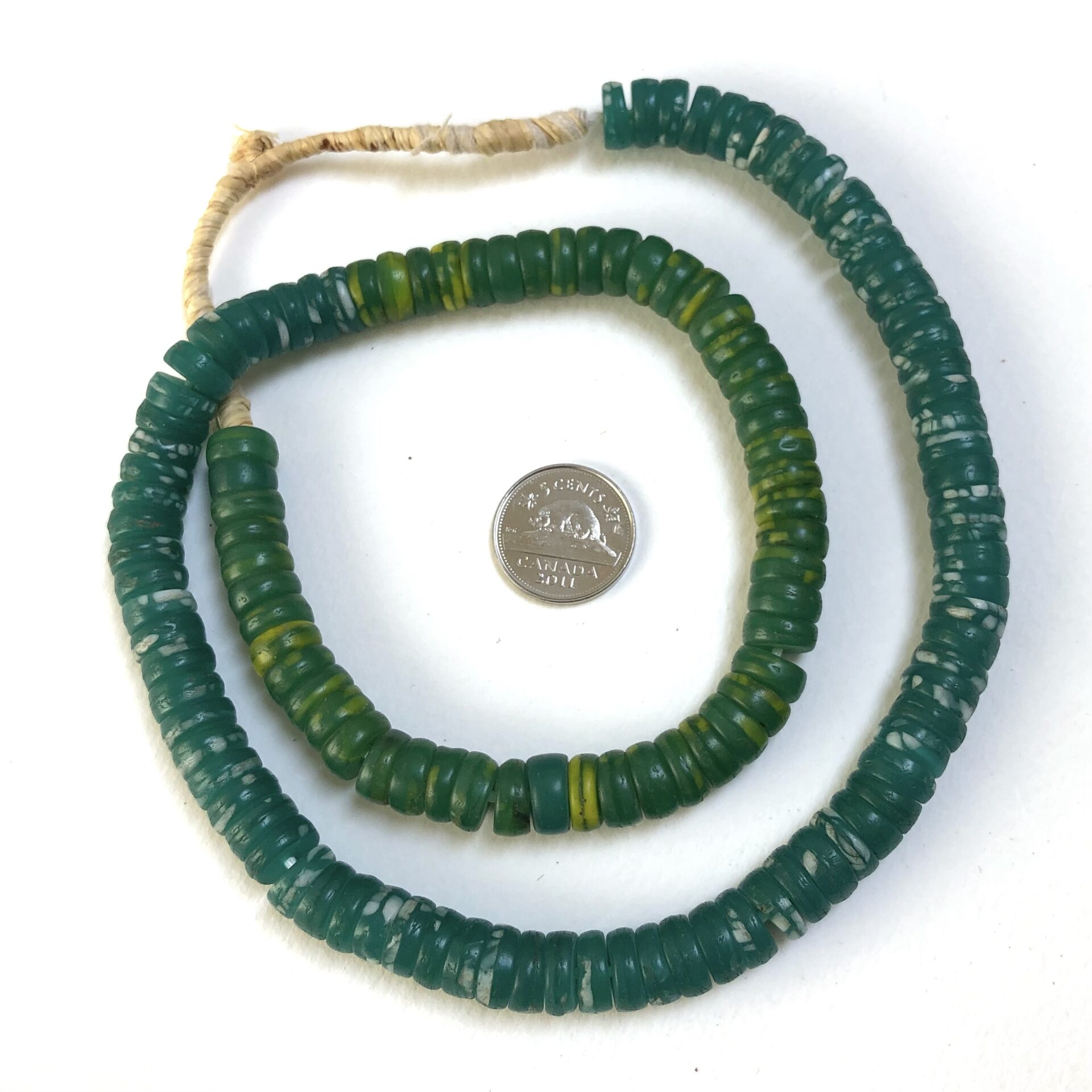
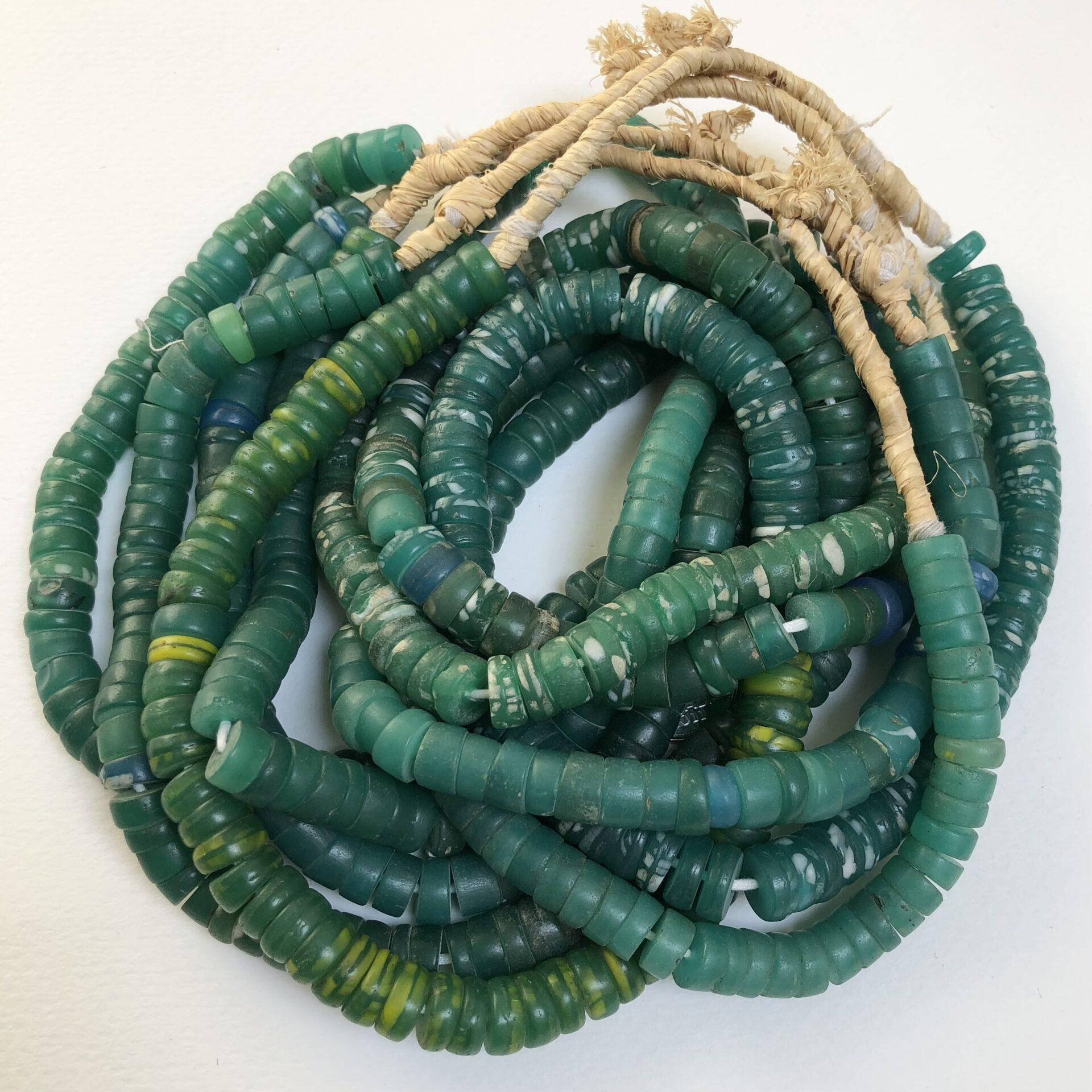 A strand of Kakamba Prosser Beads about 24" long. There are 5 strands for you to choose from. These are great spacer beads. Prosser beads are by extension any beads made by the 'Prosser' technique, invented by the Prosser brothers in 1840 in England for the purpose of making buttons. The process consists of molding a cold paste under great pressure and then firing it. Prosser Beads were distinct from other European trade beads in that they were produced in a great variety of colors, and were also translucent. They were received particularly well in the town of Kakamba in the Republic of the Congo – hence the name Kakamba Prosser Beads.
A strand of Kakamba Prosser Beads about 24" long. There are 5 strands for you to choose from. These are great spacer beads. Prosser beads are by extension any beads made by the 'Prosser' technique, invented by the Prosser brothers in 1840 in England for the purpose of making buttons. The process consists of molding a cold paste under great pressure and then firing it. Prosser Beads were distinct from other European trade beads in that they were produced in a great variety of colors, and were also translucent. They were received particularly well in the town of Kakamba in the Republic of the Congo – hence the name Kakamba Prosser Beads. -
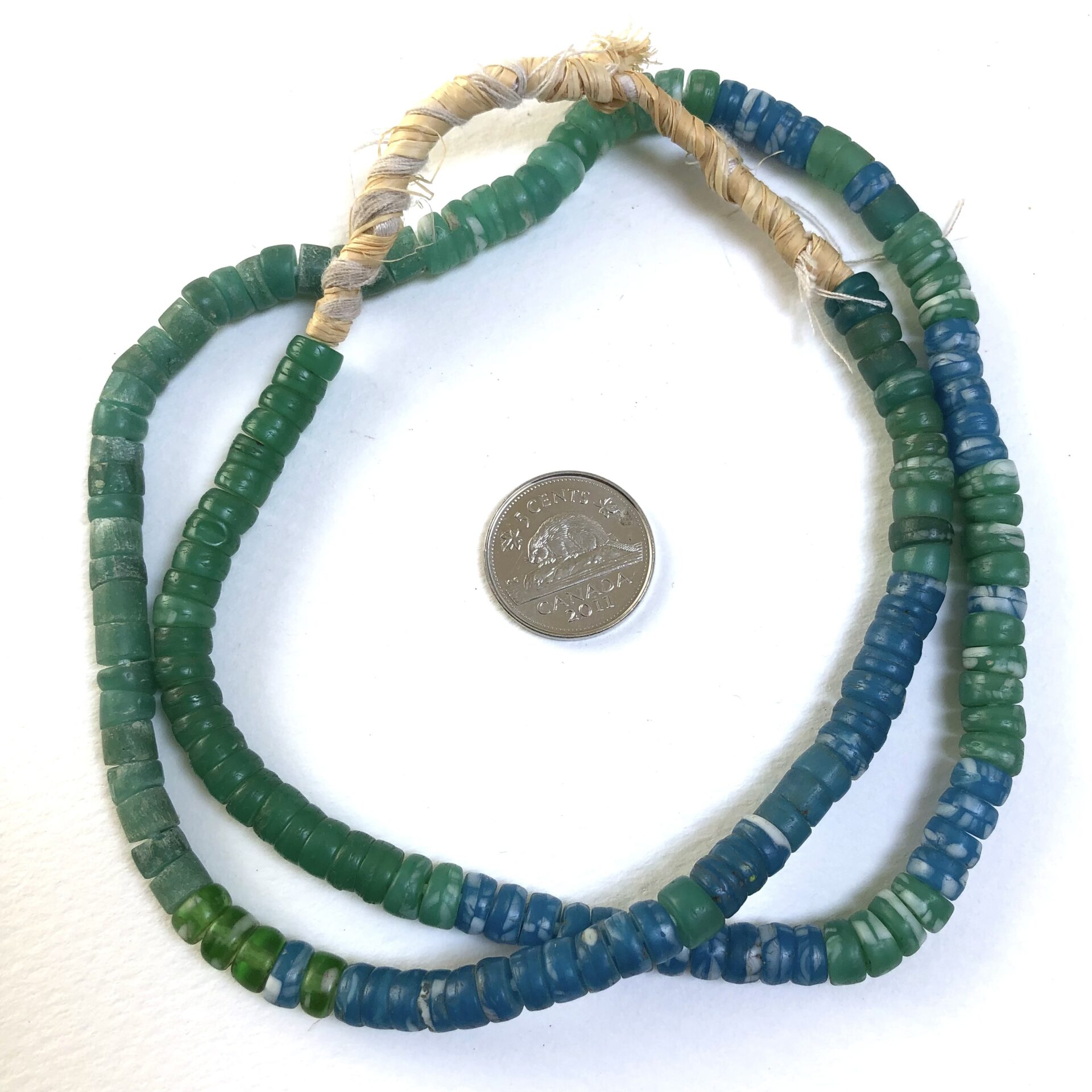
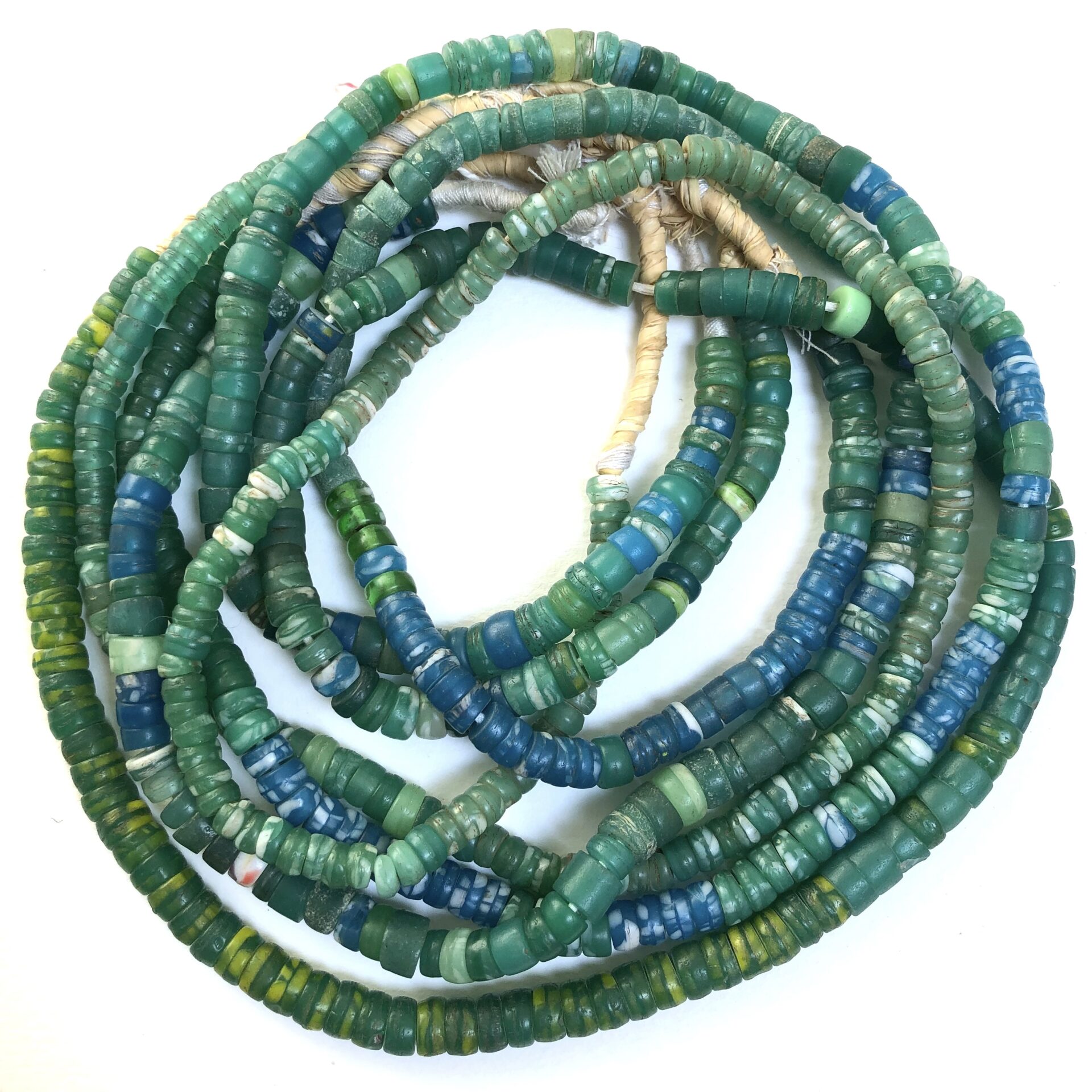 A strand of Kakamba Prosser Beads about 24" long. There are 4 strands for you to choose from. These are great spacer beads. Prosser beads are by extension any beads made by the 'Prosser' technique, invented by the Prosser brothers in 1840 in England for the purpose of making buttons. The process consists of molding a cold paste under great pressure and then firing it. Prosser Beads were distinct from other European trade beads in that they were produced in a great variety of colors, and were also translucent. They were received particularly well in the town of Kakamba in the Republic of the Congo – hence the name Kakamba Prosser Beads.
A strand of Kakamba Prosser Beads about 24" long. There are 4 strands for you to choose from. These are great spacer beads. Prosser beads are by extension any beads made by the 'Prosser' technique, invented by the Prosser brothers in 1840 in England for the purpose of making buttons. The process consists of molding a cold paste under great pressure and then firing it. Prosser Beads were distinct from other European trade beads in that they were produced in a great variety of colors, and were also translucent. They were received particularly well in the town of Kakamba in the Republic of the Congo – hence the name Kakamba Prosser Beads. -
Out of stock

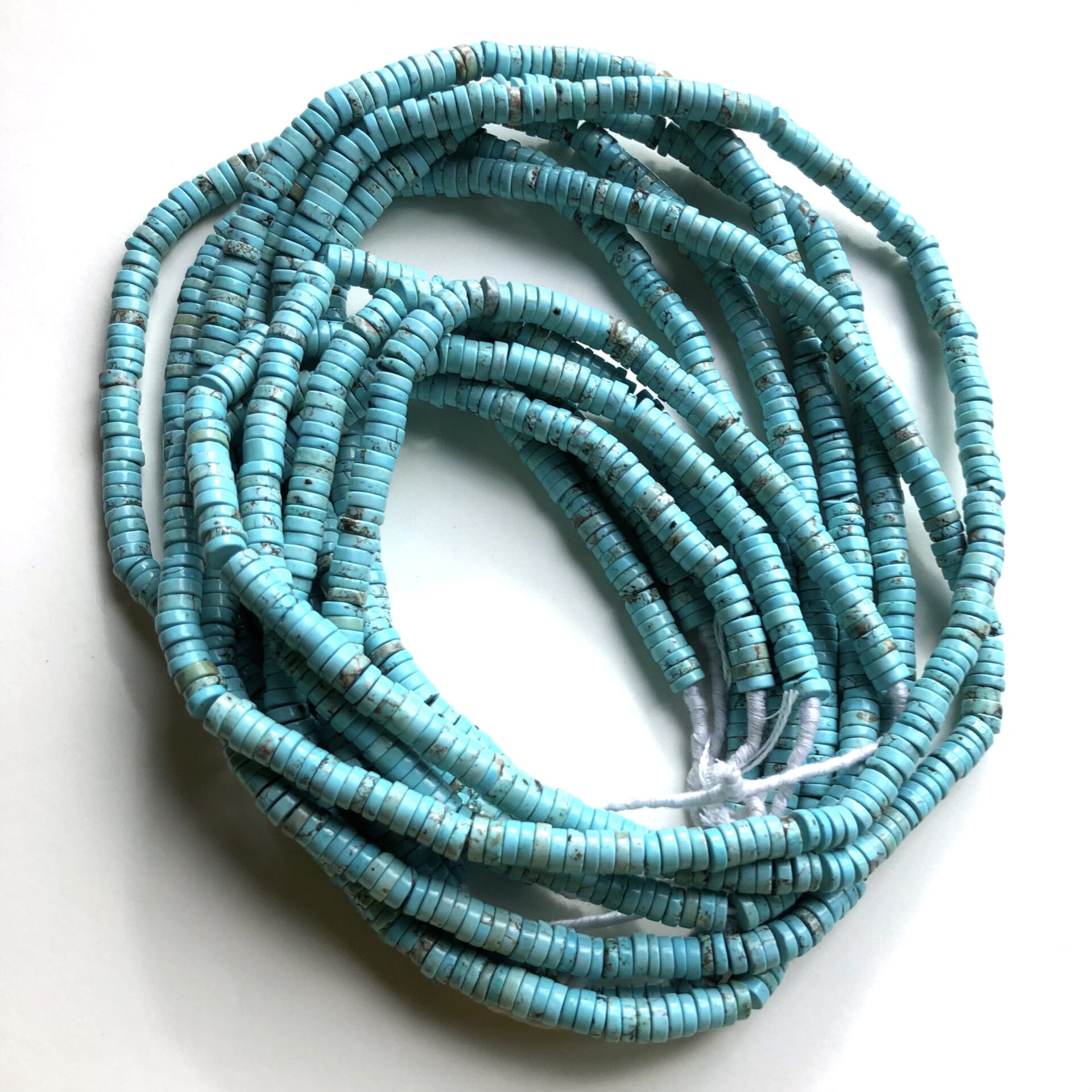 A strand of Turquoise disk beads traded in Ghana, W. Africa. Found for Funky Frog by Hidir, a favourite Trader. Each strand is about 32" and the beads are about 1x6 mm strung on string. The beads are handmade so will vary in size, shape and colour. After some research it seems these beads are probably Howlite a stone or gem in and of itself but also well known for its ability to be dyed and look like other stones/gems. Howlite is a stone of patience and perspective, for those who feel they need to slow it down, absorb, and clear the constant stream of chatter from the mind, it's a crystal that marries you to a more mindful way of life. So not 'real' turquoise' but still a treasure!
A strand of Turquoise disk beads traded in Ghana, W. Africa. Found for Funky Frog by Hidir, a favourite Trader. Each strand is about 32" and the beads are about 1x6 mm strung on string. The beads are handmade so will vary in size, shape and colour. After some research it seems these beads are probably Howlite a stone or gem in and of itself but also well known for its ability to be dyed and look like other stones/gems. Howlite is a stone of patience and perspective, for those who feel they need to slow it down, absorb, and clear the constant stream of chatter from the mind, it's a crystal that marries you to a more mindful way of life. So not 'real' turquoise' but still a treasure! -
Out of stock
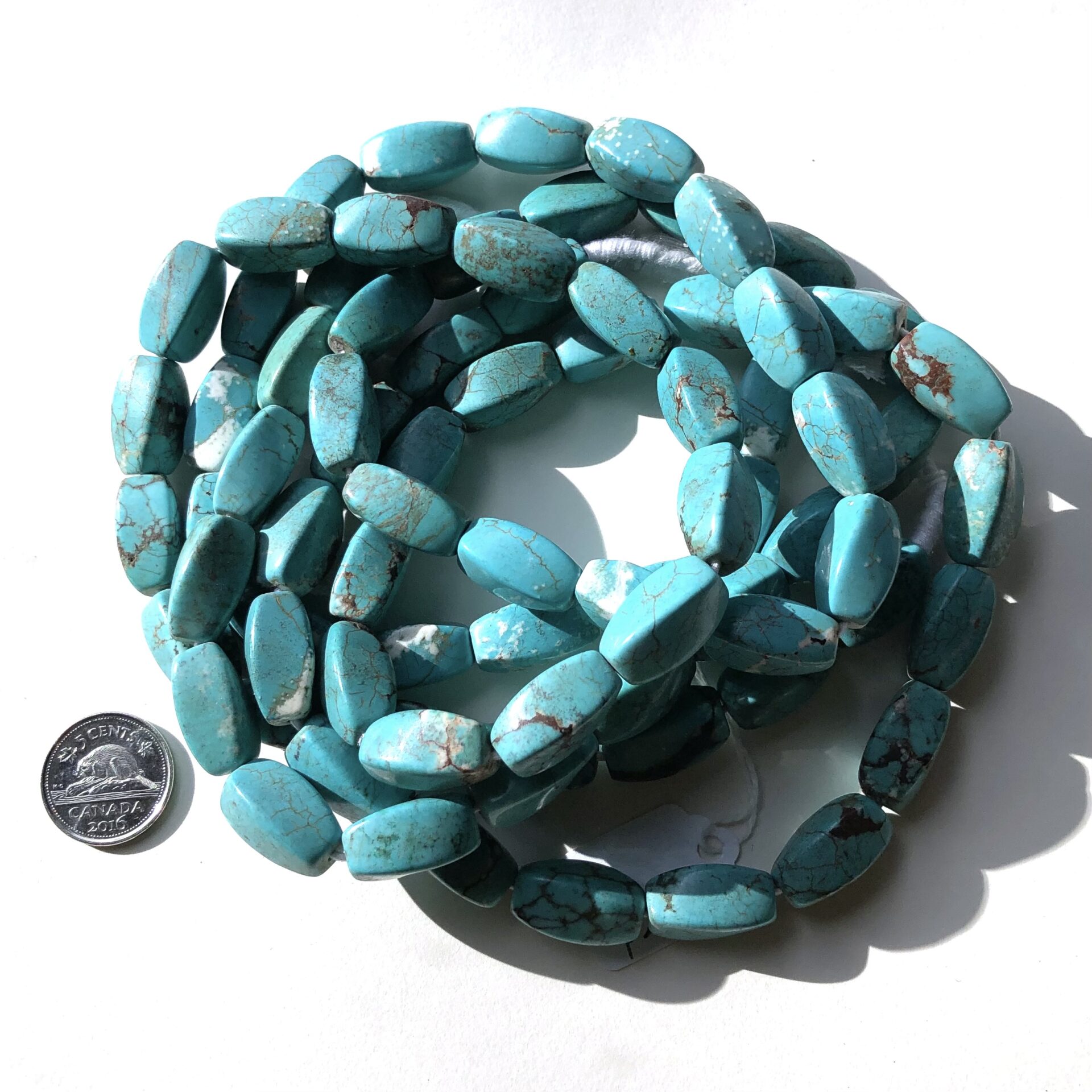
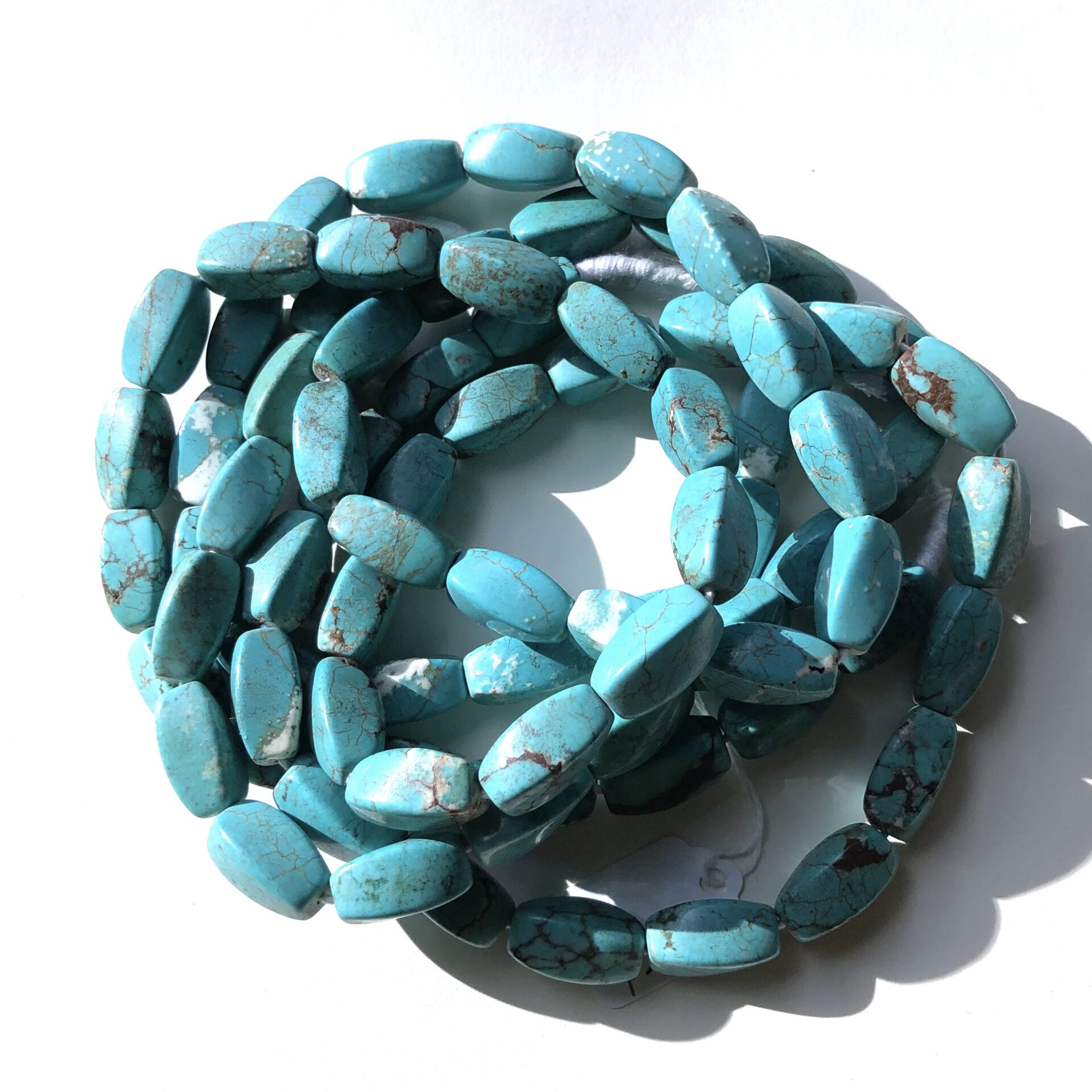 40 Turquoise faceted beads traded in Ghana, W. Africa. Found for Funky Frog by Hidir, a favourite Trader. Each bead is about 8x17 mm. The beads are strung on string about 34" long. After some research it seems these beads are probably Howlite a stone or gem in and of itself but also well known for its ability to be dyed and look like other stones/gems. Howlite is a stone of patience and perspective, for those who feel they need to slow it down, absorb, and clear the constant stream of chatter from the mind, it's a crystal that marries you to a more mindful way of life. So not 'real' turquoise' but still a treasure!
40 Turquoise faceted beads traded in Ghana, W. Africa. Found for Funky Frog by Hidir, a favourite Trader. Each bead is about 8x17 mm. The beads are strung on string about 34" long. After some research it seems these beads are probably Howlite a stone or gem in and of itself but also well known for its ability to be dyed and look like other stones/gems. Howlite is a stone of patience and perspective, for those who feel they need to slow it down, absorb, and clear the constant stream of chatter from the mind, it's a crystal that marries you to a more mindful way of life. So not 'real' turquoise' but still a treasure! -
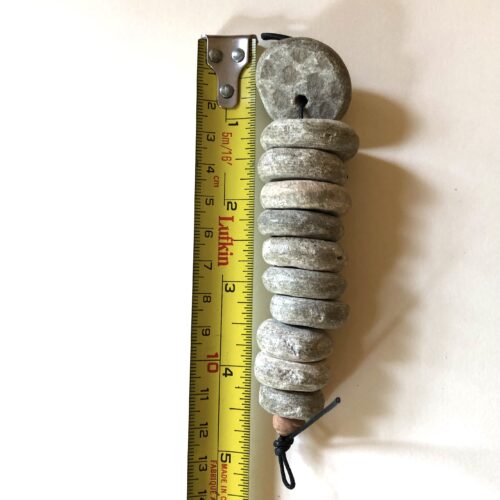
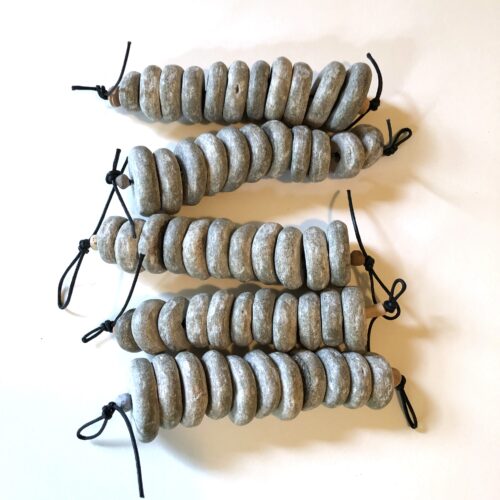 11 round disk shaped old Soft Granite Stone Beads from Mali handcrafted in the ancient methods. These unusual beads were bought in the Koforidua Beads Market in Ghana, W. Africa. They range from 15 to 28 mm. You will receive a grouping of 11 beads similar to the groupings the second image. These beads are a soft Cement Grey with a rough earthy feel and look.
11 round disk shaped old Soft Granite Stone Beads from Mali handcrafted in the ancient methods. These unusual beads were bought in the Koforidua Beads Market in Ghana, W. Africa. They range from 15 to 28 mm. You will receive a grouping of 11 beads similar to the groupings the second image. These beads are a soft Cement Grey with a rough earthy feel and look. -

 A strand of 50 gorgeous warm orange Carnelian Agate Beads found in the Koforidua Market in Ghana. The beads are well matched with the average size being 22x11 mm. The beads are strung on plastic string 42" long. The colour varies from a dark burnt orange to a light orange ... very Autumn. You will receive a strand similar to the photo. Carnelian has a lovely story ... read the blog to find out what i pieced together researching this intriguing stone .. to read more check out the blog 'Wow! Carnelian is...'
A strand of 50 gorgeous warm orange Carnelian Agate Beads found in the Koforidua Market in Ghana. The beads are well matched with the average size being 22x11 mm. The beads are strung on plastic string 42" long. The colour varies from a dark burnt orange to a light orange ... very Autumn. You will receive a strand similar to the photo. Carnelian has a lovely story ... read the blog to find out what i pieced together researching this intriguing stone .. to read more check out the blog 'Wow! Carnelian is...' -

 A strand of Kakamba Prosser Beads about 24" long. The glass beads are about 3-4 mm in diameter. These are great spacer beads.3/4 of the beads are a translucent yellot and the rest are an opaque yellow, black and red mix. Prosser beads are by extension any beads made by the 'Prosser' technique, invented by the Prosser brothers in 1840 in England for the purpose of making buttons. The process consists of molding a cold paste under great pressure and then firing it. Prosser Beads were distinct from other European trade beads in that they were produced in a great variety of colors, and were also translucent. They were received particularly well in the town of Kakamba in the Republic of the Congo – hence the name Kakamba Prosser Beads.
A strand of Kakamba Prosser Beads about 24" long. The glass beads are about 3-4 mm in diameter. These are great spacer beads.3/4 of the beads are a translucent yellot and the rest are an opaque yellow, black and red mix. Prosser beads are by extension any beads made by the 'Prosser' technique, invented by the Prosser brothers in 1840 in England for the purpose of making buttons. The process consists of molding a cold paste under great pressure and then firing it. Prosser Beads were distinct from other European trade beads in that they were produced in a great variety of colors, and were also translucent. They were received particularly well in the town of Kakamba in the Republic of the Congo – hence the name Kakamba Prosser Beads. -

 A strand of Kakamba Prosser Beads about 23" long. The glass beads are about 5 mm in diameter. These are great spacer beads. An assortment of colours. You will receive a strand similar to the strands shown. There are variations between strands. Prosser beads are by extension any beads made by the 'Prosser' technique, invented by the Prosser brothers in 1840 in England for the purpose of making buttons. The process consists of molding a cold paste under great pressure and then firing it. Prosser Beads were distinct from other European trade beads in that they were produced in a great variety of colors, and were also translucent. They were received particularly well in the town of Kakamba in the Republic of the Congo – hence the name Kakamba Prosser Beads.
A strand of Kakamba Prosser Beads about 23" long. The glass beads are about 5 mm in diameter. These are great spacer beads. An assortment of colours. You will receive a strand similar to the strands shown. There are variations between strands. Prosser beads are by extension any beads made by the 'Prosser' technique, invented by the Prosser brothers in 1840 in England for the purpose of making buttons. The process consists of molding a cold paste under great pressure and then firing it. Prosser Beads were distinct from other European trade beads in that they were produced in a great variety of colors, and were also translucent. They were received particularly well in the town of Kakamba in the Republic of the Congo – hence the name Kakamba Prosser Beads. -

 A strand of over 150 Kakamba Prosser Beads about 32" long. There are two different strands to choose from. These are great spacer beads. The bead is a shade of translucent green. Prosser beads are by extension any beads made by the 'Prosser' technique, invented by the Prosser brothers in 1840 in England for the purpose of making buttons. The process consists of molding a cold paste under great pressure and then firing it. Prosser Beads were distinct from other European trade beads in that they were produced in a great variety of colors, and were also translucent. They were received particularly well in the town of Kakamba in the Republic of the Congo – hence the name Kakamba Prosser Beads.
A strand of over 150 Kakamba Prosser Beads about 32" long. There are two different strands to choose from. These are great spacer beads. The bead is a shade of translucent green. Prosser beads are by extension any beads made by the 'Prosser' technique, invented by the Prosser brothers in 1840 in England for the purpose of making buttons. The process consists of molding a cold paste under great pressure and then firing it. Prosser Beads were distinct from other European trade beads in that they were produced in a great variety of colors, and were also translucent. They were received particularly well in the town of Kakamba in the Republic of the Congo – hence the name Kakamba Prosser Beads. -

 A strand of over 125 Kakamba Prosser Beads about 31" long. The beads are about 12 mm in diameter. These are great spacer beads.The beads are a translucent light green. You will get one or other of the strands shown. Prosser beads are by extension any beads made by the 'Prosser' technique, invented by the Prosser brothers in 1840 in England for the purpose of making buttons. The process consists of molding a cold paste under great pressure and then firing it. Prosser Beads were distinct from other European trade beads in that they were produced in a great variety of colors, and were also translucent. They were received particularly well in the town of Kakamba in the Republic of the Congo – hence the name Kakamba Prosser Beads.
A strand of over 125 Kakamba Prosser Beads about 31" long. The beads are about 12 mm in diameter. These are great spacer beads.The beads are a translucent light green. You will get one or other of the strands shown. Prosser beads are by extension any beads made by the 'Prosser' technique, invented by the Prosser brothers in 1840 in England for the purpose of making buttons. The process consists of molding a cold paste under great pressure and then firing it. Prosser Beads were distinct from other European trade beads in that they were produced in a great variety of colors, and were also translucent. They were received particularly well in the town of Kakamba in the Republic of the Congo – hence the name Kakamba Prosser Beads. -

 A strand of Kakamba Prosser Beads about 30" long. The beads are about 7-8 mm in diameter. These are great spacer beads.The beads are a translucent various shade of green. You will get the strand shown. Prosser beads are by extension any beads made by the 'Prosser' technique, invented by the Prosser brothers in 1840 in England for the purpose of making buttons. The process consists of molding a cold paste under great pressure and then firing it. Prosser Beads were distinct from other European trade beads in that they were produced in a great variety of colors, and were also translucent. They were received particularly well in the town of Kakamba in the Republic of the Congo – hence the name Kakamba Prosser Beads.
A strand of Kakamba Prosser Beads about 30" long. The beads are about 7-8 mm in diameter. These are great spacer beads.The beads are a translucent various shade of green. You will get the strand shown. Prosser beads are by extension any beads made by the 'Prosser' technique, invented by the Prosser brothers in 1840 in England for the purpose of making buttons. The process consists of molding a cold paste under great pressure and then firing it. Prosser Beads were distinct from other European trade beads in that they were produced in a great variety of colors, and were also translucent. They were received particularly well in the town of Kakamba in the Republic of the Congo – hence the name Kakamba Prosser Beads. -
 A strand of Kakamba Prosser Beads about 32" long. The beads are about 8 mm in diameter. These are great spacer beads.The beads are a gorgeous translucent light green. There are two strands very similar to choose from. Prosser beads are by extension any beads made by the 'Prosser' technique, invented by the Prosser brothers in 1840 in England for the purpose of making buttons. The process consists of molding a cold paste under great pressure and then firing it. Prosser Beads were distinct from other European trade beads in that they were produced in a great variety of colors, and were also translucent. They were received particularly well in the town of Kakamba in the Republic of the Congo – hence the name Kakamba Prosser Beads.
A strand of Kakamba Prosser Beads about 32" long. The beads are about 8 mm in diameter. These are great spacer beads.The beads are a gorgeous translucent light green. There are two strands very similar to choose from. Prosser beads are by extension any beads made by the 'Prosser' technique, invented by the Prosser brothers in 1840 in England for the purpose of making buttons. The process consists of molding a cold paste under great pressure and then firing it. Prosser Beads were distinct from other European trade beads in that they were produced in a great variety of colors, and were also translucent. They were received particularly well in the town of Kakamba in the Republic of the Congo – hence the name Kakamba Prosser Beads. -
Out of stock

 A strand of about 74 Kakamba Prosser Beads on string 30" long. Each bead is about 11 mm in diameter. These are great spacer beads. Prosser beads are by extension any beads made by the 'Prosser' technique, invented by the Prosser brothers in 1840 in England for the purpose of making buttons. The process consists of molding a cold paste under great pressure and then firing it. Prosser Beads were distinct from other European trade beads in that they were produced in a great variety of colors, and were also translucent. They were received particularly well in the town of Kakamba in the Republic of the Congo – hence the name Kakamba Prosser Beads.
A strand of about 74 Kakamba Prosser Beads on string 30" long. Each bead is about 11 mm in diameter. These are great spacer beads. Prosser beads are by extension any beads made by the 'Prosser' technique, invented by the Prosser brothers in 1840 in England for the purpose of making buttons. The process consists of molding a cold paste under great pressure and then firing it. Prosser Beads were distinct from other European trade beads in that they were produced in a great variety of colors, and were also translucent. They were received particularly well in the town of Kakamba in the Republic of the Congo – hence the name Kakamba Prosser Beads. -

 A strand of Kakamba Prosser Beads about 30" long. The glass beads are about 6-9 mm in diameter. These are great spacer beads. You will receive the strand displayed. Prosser beads are by extension any beads made by the 'Prosser' technique, invented by the Prosser brothers in 1840 in England for the purpose of making buttons. The process consists of molding a cold paste under great pressure and then firing it. Prosser Beads were distinct from other European trade beads in that they were produced in a great variety of colors, and were also translucent. They were received particularly well in the town of Kakamba in the Republic of the Congo – hence the name Kakamba Prosser Beads.
A strand of Kakamba Prosser Beads about 30" long. The glass beads are about 6-9 mm in diameter. These are great spacer beads. You will receive the strand displayed. Prosser beads are by extension any beads made by the 'Prosser' technique, invented by the Prosser brothers in 1840 in England for the purpose of making buttons. The process consists of molding a cold paste under great pressure and then firing it. Prosser Beads were distinct from other European trade beads in that they were produced in a great variety of colors, and were also translucent. They were received particularly well in the town of Kakamba in the Republic of the Congo – hence the name Kakamba Prosser Beads. -

 A strand of Kakamba Prosser Beads about 30" long. The glass beads are about 7 mm in diameter. These are great spacer beads. You will receive one of the strands displayed. Prosser beads are by extension any beads made by the 'Prosser' technique, invented by the Prosser brothers in 1840 in England for the purpose of making buttons. The process consists of molding a cold paste under great pressure and then firing it. Prosser Beads were distinct from other European trade beads in that they were produced in a great variety of colors, and were also translucent. They were received particularly well in the town of Kakamba in the Republic of the Congo – hence the name Kakamba Prosser Beads.
A strand of Kakamba Prosser Beads about 30" long. The glass beads are about 7 mm in diameter. These are great spacer beads. You will receive one of the strands displayed. Prosser beads are by extension any beads made by the 'Prosser' technique, invented by the Prosser brothers in 1840 in England for the purpose of making buttons. The process consists of molding a cold paste under great pressure and then firing it. Prosser Beads were distinct from other European trade beads in that they were produced in a great variety of colors, and were also translucent. They were received particularly well in the town of Kakamba in the Republic of the Congo – hence the name Kakamba Prosser Beads. -

 A strand of Kakamba Prosser Beads about 32" long. The glass beads are about 9 mm in diameter. These are great spacer beads. You will receive the strand displayed with the penny. Prosser beads are by extension any beads made by the 'Prosser' technique, invented by the Prosser brothers in 1840 in England for the purpose of making buttons. The process consists of molding a cold paste under great pressure and then firing it. Prosser Beads were distinct from other European trade beads in that they were produced in a great variety of colors, and were also translucent. They were received particularly well in the town of Kakamba in the Republic of the Congo – hence the name Kakamba Prosser Beads.
A strand of Kakamba Prosser Beads about 32" long. The glass beads are about 9 mm in diameter. These are great spacer beads. You will receive the strand displayed with the penny. Prosser beads are by extension any beads made by the 'Prosser' technique, invented by the Prosser brothers in 1840 in England for the purpose of making buttons. The process consists of molding a cold paste under great pressure and then firing it. Prosser Beads were distinct from other European trade beads in that they were produced in a great variety of colors, and were also translucent. They were received particularly well in the town of Kakamba in the Republic of the Congo – hence the name Kakamba Prosser Beads. -
Out of stock

 A strand of blue Kakamba Prosser Beads about 34" long. The glass beads are about 8 mm in diameter. These are great spacer beads. Prosser beads are by extension any beads made by the 'Prosser' technique, invented by the Prosser brothers in 1840 in England for the purpose of making buttons. The process consists of molding a cold paste under great pressure and then firing it. Prosser Beads were distinct from other European trade beads in that they were produced in a great variety of colors, and were also translucent. They were received particularly well in the town of Kakamba in the Republic of the Congo – hence the name Kakamba Prosser Beads.
A strand of blue Kakamba Prosser Beads about 34" long. The glass beads are about 8 mm in diameter. These are great spacer beads. Prosser beads are by extension any beads made by the 'Prosser' technique, invented by the Prosser brothers in 1840 in England for the purpose of making buttons. The process consists of molding a cold paste under great pressure and then firing it. Prosser Beads were distinct from other European trade beads in that they were produced in a great variety of colors, and were also translucent. They were received particularly well in the town of Kakamba in the Republic of the Congo – hence the name Kakamba Prosser Beads. -

 A strand of Kakamba Prosser Beads about 22" long. The glass beads are about 6-12 mm in diameter. These are great spacer beads. You will receive the strand displayed. Prosser beads are by extension any beads made by the 'Prosser' technique, invented by the Prosser brothers in 1840 in England for the purpose of making buttons. The process consists of molding a cold paste under great pressure and then firing it. Prosser Beads were distinct from other European trade beads in that they were produced in a great variety of colors, and were also translucent. They were received particularly well in the town of Kakamba in the Republic of the Congo – hence the name Kakamba Prosser Beads.
A strand of Kakamba Prosser Beads about 22" long. The glass beads are about 6-12 mm in diameter. These are great spacer beads. You will receive the strand displayed. Prosser beads are by extension any beads made by the 'Prosser' technique, invented by the Prosser brothers in 1840 in England for the purpose of making buttons. The process consists of molding a cold paste under great pressure and then firing it. Prosser Beads were distinct from other European trade beads in that they were produced in a great variety of colors, and were also translucent. They were received particularly well in the town of Kakamba in the Republic of the Congo – hence the name Kakamba Prosser Beads. -

 A strand of Kakamba Prosser Beads about 32" long. There are two of these stands that are very similar. However you can choose between the strand where the beads are all about 12 mm or the strand where the beads vary between 9 to 12 mm in diameter. These are great spacer beads.The majority are a translucent green with some that are speckled with white. Prosser beads are by extension any beads made by the 'Prosser' technique, invented by the Prosser brothers in 1840 in England for the purpose of making buttons. The process consists of molding a cold paste under great pressure and then firing it. Prosser Beads were distinct from other European trade beads in that they were produced in a great variety of colors, and were also translucent. They were received particularly well in the town of Kakamba in the Republic of the Congo – hence the name Kakamba Prosser Beads.
A strand of Kakamba Prosser Beads about 32" long. There are two of these stands that are very similar. However you can choose between the strand where the beads are all about 12 mm or the strand where the beads vary between 9 to 12 mm in diameter. These are great spacer beads.The majority are a translucent green with some that are speckled with white. Prosser beads are by extension any beads made by the 'Prosser' technique, invented by the Prosser brothers in 1840 in England for the purpose of making buttons. The process consists of molding a cold paste under great pressure and then firing it. Prosser Beads were distinct from other European trade beads in that they were produced in a great variety of colors, and were also translucent. They were received particularly well in the town of Kakamba in the Republic of the Congo – hence the name Kakamba Prosser Beads. -

 A strand of Kakamba Prosser Beads about 23" long. The glass beads are about 6-9 mm in diameter. These are great spacer beads. An assortment of colours and sizes. You will receive the strand shown. Prosser beads are by extension any beads made by the 'Prosser' technique, invented by the Prosser brothers in 1840 in England for the purpose of making buttons. The process consists of molding a cold paste under great pressure and then firing it. Prosser Beads were distinct from other European trade beads in that they were produced in a great variety of colors, and were also translucent. They were received particularly well in the town of Kakamba in the Republic of the Congo – hence the name Kakamba Prosser Beads.
A strand of Kakamba Prosser Beads about 23" long. The glass beads are about 6-9 mm in diameter. These are great spacer beads. An assortment of colours and sizes. You will receive the strand shown. Prosser beads are by extension any beads made by the 'Prosser' technique, invented by the Prosser brothers in 1840 in England for the purpose of making buttons. The process consists of molding a cold paste under great pressure and then firing it. Prosser Beads were distinct from other European trade beads in that they were produced in a great variety of colors, and were also translucent. They were received particularly well in the town of Kakamba in the Republic of the Congo – hence the name Kakamba Prosser Beads.


